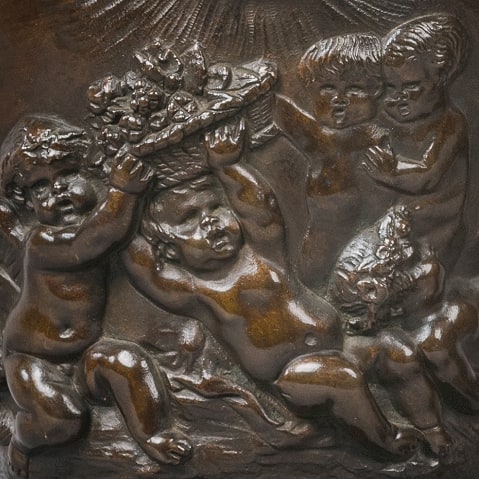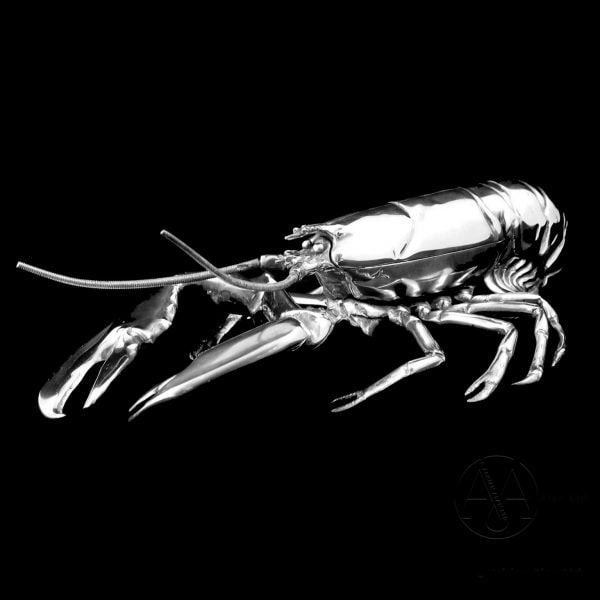在克劳德-米歇尔-克罗迪昂之后
一对精美的铜制百草园花瓶
£4,600
A Fine Pair of Patinated Bronze Bacchanalian Vases, After Clodion. Cast after the design by Clodion, the vases are modelled with masks depicting chimerical...
尺寸
Height: 37 cm (15 in)Width: 17 cm (7 in)
Depth: 13 cm (6 in)
描述
A Fine Pair of Patinated Bronze Bacchanalian Vases, After Clodion.
Cast after the design by Clodion, the vases are modelled with masks depicting chimerical ibex flanked by laurel swags, above a finely carved reliefs of young Bacchanals at play. Each vase is raised on a fluted circular base and put down on a black marble octagonal socle.
The vases which display a classical iconography blending architectural elements of antiquity with the sensibility of the ‘ancient régime’ are after a model by the celebrated sculptor Claude Michael Clodion (1738-1814), made during his time at the French Academy in Rome from 1762 to 1771. One noted terracotta example, formerly in the collection of the princely Russian Dolgoroukov family, is now in the Hermitage Museum, St. Petersburg (H.CK-2093), exhibited at the Clodion exhibition, musee du Louvre in 1992. A related example in marble, notably in the treatment of the masks, is in the Wallace Collection, London (S32).
Clodion’s design for this pair of vases may have been influenced by a chalk drawing for a vase by François Boucher from circa 1761-1762 in which we see Bacchanalian parades and acanthus detail that is similar to Clodion’s vase designs. François Boucher (1703 – 1770) was the leading French artist working in the Rococo style and possibly the most celebrated artist of the eighteenth century, most known for his idyllic paintings on classical themes. It is possible that this drawing served as inspiration for Clodion when designing his vases, which were executed in various versions between 1763 and 1785 and continued to be adapted well into the nineteenth century by later artists.
A similar design of vase appears in several of Boucher’s paintings, including Earth: Vertumnus and Pomona from 1749, now in the Columbus Museum of Art, Ohio (1980.027). Boucher had a strong impact on Clodion, who perhaps sculpted works after his drawings, supported by the fact that three paintings were included in Clodion’s personal inventory upon his death in 1814, “trois tableaux de Boucher représentant jeux d’enfants, peints sur bois, prises ensemble 3 fr”.
法国,约1890年。
日期
约1890年
原产地
法国
中型
Patinated Bronze
The son-in-law of sculptor Augustin Pajou, Clodion, (Claude Michel), (1738-1814), trained in Paris in the workshops of his uncle and Jean-Baptiste Pigalle, the most successful sculptor of the time. After winning the Prix de Rome, he moved to Italy, sharing a studio with Jean-Antoine Houdon and studying antique, Renaissance, and Baroque sculpture.
In 1771 Clodion returned to Paris, where he continued to produce mostly in terracotta. He also worked with his brothers in other media, decorating objects such as candelabra, clocks, and vases. Drawing primarily from pagan antiquity, he created light-hearted terracotta sculptures that epitomised the Rococo style. Late in his life, when Neo-classical works were more popular, Clodion adjusted his style and worked on major public monuments in Paris.














 印刷品
印刷品


